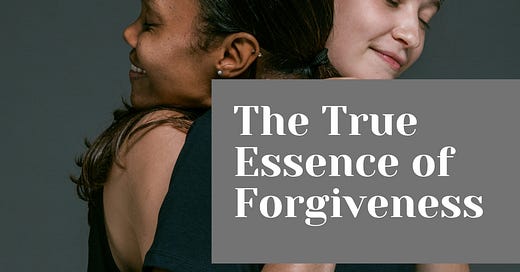The True Essence of Forgiveness
Unraveling the Emotional and Cognitive Dimensions of Letting Go
Note: This is the second post in a five-part series on forgiveness. Click here for the previous article.
In last week’s post, I described several myths about forgiveness, including the ideas that: (1) forgiving means forgetting; (2) forgiving means that you won’t feel negative emotions about the situation; (3) you either forgive or you don’t; and (4) forgiveness requires reconciliation. These are common – and sometimes dangerous – misperceptions about forgiveness. But if forgiveness isn’t any of these things, then what is it?
Forgiveness can be hard to pin down. Christians often think of it solely as a biblical process, but forgiveness is fundamental to human relationships across religion and culture. It’s not even just human; there’s evidence of it among animals, too. In essence, forgiveness is how we maintain connection and community when it gets hard, when we commit wrongs against one another. Doing harm to one another is inevitable in relationships. Without forgiveness, we could never maintain friendships, marriages, and family relationships. So while forgiveness is a theological process, it is also a relational, social, and psychological process.
Forgiveness is how we maintain connection and community when it gets hard.
Forgiveness is an internal process that is directed toward another person. It is the process that we utilize to transform the negative feelings – including anger, resentment, hostility, blame, fear, and condemnation – toward someone whom we perceive as having done wrong. This could be another person, but it could also be ourselves.
Notice my use of the word “perceive.” The need for forgiveness arises when we perceive that someone has done something wrong. Everett Worthington, a counseling psychologist and leading researcher on forgiveness, calls this the “injustice gap,” the discrepancy between what someone does and what we think they should have done. Different people have different injustice gaps, based upon our personalities (some personality types are more prone to forgiving than others), our stress and coping (we get more ticked off by smaller events when we are highly stressed), the nature of the relationship, and the characteristics of the offense.
Since the need for forgiveness is precipitated by a specific situation or event, forgiveness itself must be specific. In other words, we forgive (and are forgiven by) specific people for specific wrongs. If we forgive a person and they later commit another offense, the old forgiveness process doesn’t automatically carry over.
Being in ongoing relationship with someone means that there are many opportunities to offend and to be offended. This is especially true of emotionally close relationships. Marriage and committed romantic relationships can give us opportunities to practice forgiveness everyday, sometimes multiple times!
One of the leading experts in forgiveness research is Everett Worthington, a counseling psychologist whose work focuses on forgiveness and reconciliation, marriage counseling, and spirituality. In his book, Forgiveness and Reconciliation, Worthington states that “Forgiveness is a global term that suggests changes over time. Because all sorts of events happen over time, it is often difficult to say whether we have ‘fully forgiven’ once and for all time.”
Worthington distinguishes between two types of forgiveness: decisional and emotional forgiveness. Decisional forgiveness is a cognitive process. It occurs, like it says, when we decide to forgive a person. Decisional forgiveness is aspirational. It expresses an intention or commitment that may not be realized yet.
Emotional forgiveness, in contrast, is a longer process and one that is not always under our conscious control. It occurs when when our negative feelings toward the offender about the offense are eliminated, either completely or mostly. We can recall the event without experiencing the negative feelings toward the person.
Decisional and emotional forgiveness do not always coincide. Sometimes we decide to forgive a person but never reach emotional forgiveness (or it takes years). And interestingly, sometimes we realize that we have forgiven a person without ever consciously deciding to do so. Moreover, we are not always aware of when we have reached emotional forgiveness.
So how do we get there? Sometimes time alone is enough. Other times, reaching emotional forgiveness requires intentional effort, including our own healing and recovery work. What’s important is that we strive to cultivate forgiveness while also allowing the process to take its time. If all we can do is desire to decide to forgive, then we should accept that.
What’s important is that we strive to cultivate forgiveness while also allowing the process to take its time.
We must also accept that forgiveness is the work of the person who perceives the injustice gap. In other words, it does not require the participation of everyone involved in the incident (reconciliation does and we’ll visit that later). Forgiveness is the inner work that we do regardless of what the other person does. It does not require them to apologize, to repent, to change, or even to commit to refraining from the offense again. We do not have to communicate it to the person. And if we choose to do so, it’s possible that what we are communicating is that we have decided to forgive, not that we have completed the process.






This is very helpful!